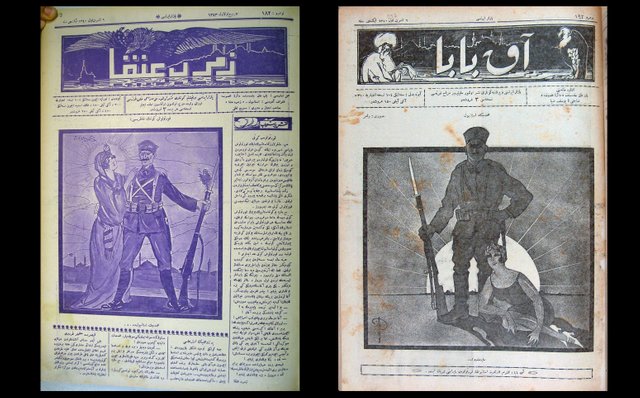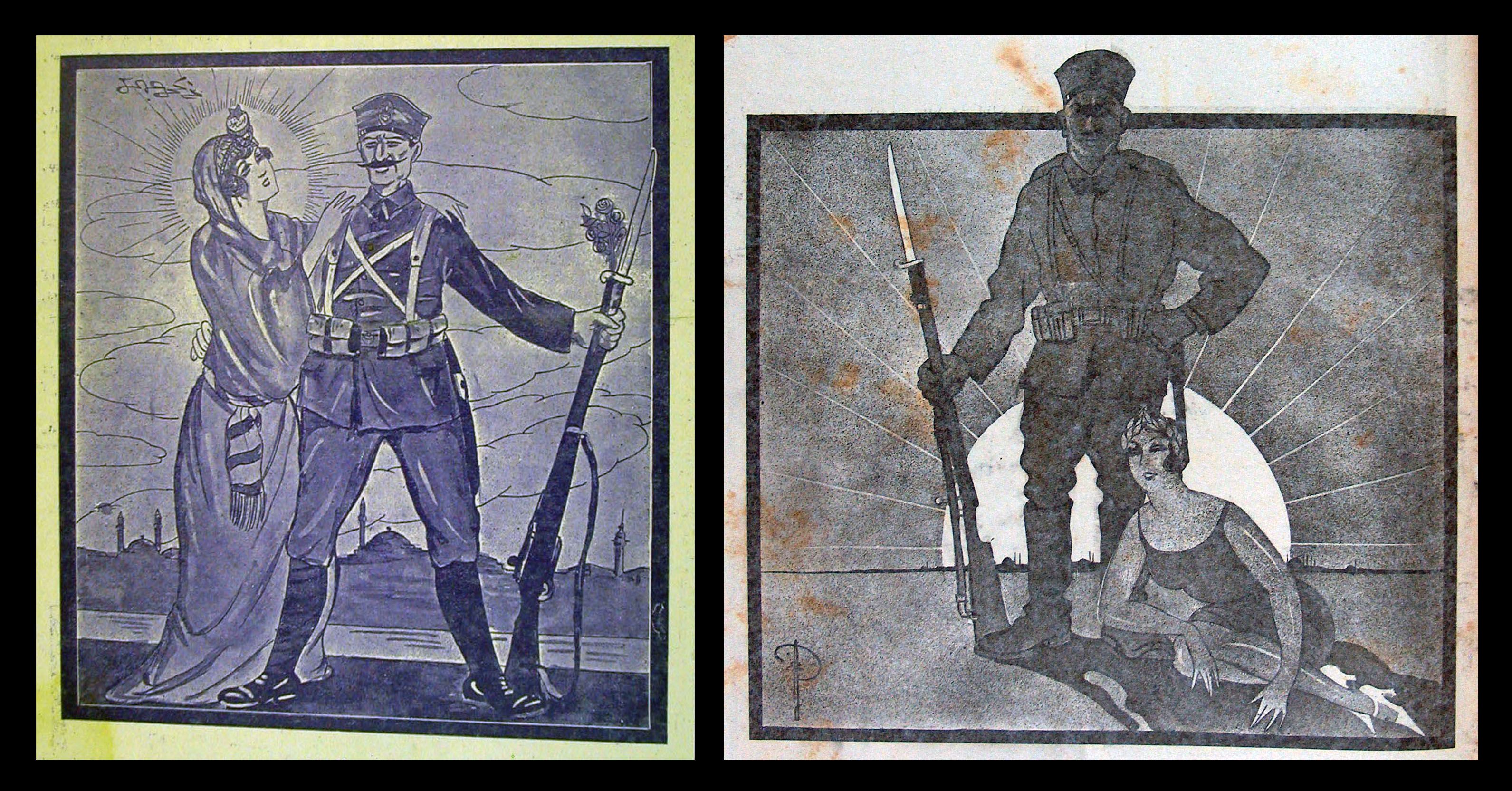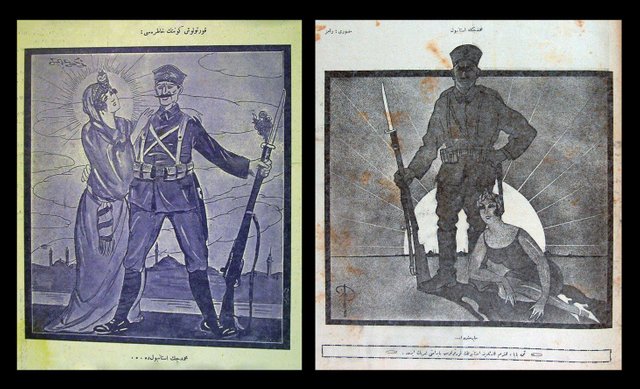116. Today in 1920s Turkey: 6 October 1924 (On the One-Year Anniversary of Istanbul’s Liberation)

(The cover pages of Akbaba and Zümrüdüanka from 6 October 1924.)
Comments:
Ninety-three years ago today, Istanbulites celebrated the one year anniversary of the city’s liberation (kurtuluş) from Allied forces. The capital city of Istanbul fell under Allied occupation following the Ottoman Empire’s defeat in WWI. The occupation, which began on 12 November 1918, lasted throughout the Turkish War of Independence and technically ended with the signing of the Treaty of Lausanne on 24 July 1923. Although the withdrawal of the final troops took place on 23 September 1923, the city’s official liberation day is two weeks later, on 6 October—the day the first Turkish troops marched into Istanbul.
A year later the largely Istanbul-based press did not neglect to enthusiastically remember this momentous event on the day of its anniversary. Today we consider the front-page illustrations for two magazines published on the exact same day. Not all weekly or bi-weekly magazines would have been scheduled to publish on the exact day of the anniversary because they usually published on fixed days of the week (which would not be changed for the sake of holidays and the like). Rather, if a holiday falls on a day that the journal does not publish, they would reference it in the issue before or after the given day. Since both Akbaba and Zümrüdüanka were published on Mondays and Thursdays and 6 October 1924 fell on a Monday, we have at our disposal two examples of very similarly motivated content to examine side-by-side. This is why I could not resist making a dual-content post for today.

Even a cursory glance at the two images reveals that they have much in common. Both include five basic visual elements: soldier, woman, bayonet, sun, and the Istanbul skyline. These two examples also reveal noteworthy similarities in composition. Both scenes are framed with strong borders and feature the bayonet-bearing soldier at their centers. In both cases, the solitary soldier is a stand-in for the triumphant Turkish military. The backgrounds of both compositions are marked with the familiar rhythm of minarets and domes that comprises Istanbul’s unique skyline. Whereas in the Akbaba example (right) the city is located quite a distance away, the Zümrüdüanka (left) version depicts the soldier standing on the shore opposite the historical peninsula. Regardless of the location of the city’s skyline, however, Istanbul is nearby because the woman alongside the soldier is a personification of the fair city.
The two images differ from one another in the placement and depiction of their respective Istanbul personifications. As the violated party, Istanbul is depicted as a beautiful damsel in distress, leaning on or clinging to the Turkish soldier. Akbaba’s Istanbul (right) is a modern woman complete with raccoon-eye make-up, a fashionable bob-cut, flapper dress, and snazzy white heels. Zümrüdüanka’s Istanbul, on the other hand, resembles a more traditional woman—her loose headscarf, flowing robes, and patterned sash reminiscent of a female figure from a classical Ottoman or Persianate manuscript illustration (i.e. miniature paintings). Both Istanbul figures lean on the soldier: one standing, the other reclining at his feet.
Finally, as the universal abbreviation for bright new beginnings, the sun factors into both compositions. Shining bright and looming large over the city, the sun in Akbaba's illustration is at the center of the image. Even its rays are visible as they emanate from behind the two protagonists. In Zümrüdüanka’s iteration of the same scene the sun has risen to a space directly behind the female figure’s head. Located much higher in the sky than the Akbaba version, this sun doubles as a halo to Istanbul’s head.
Although very similar in content, the two images were made by two different artists. The illustration on the right is signed by Ramiz Bey, an artist with whom Today in 1920s Turkey is already well acquainted. Unfortunately, I am not familiar with the artist associated with the signature on the left image. In any case, one can only imagine how disappointed the artists must have been that morning when they saw the covers of each other’s magazines and realized the similarities between their own work and that of their colleague!

Each image is sandwiched between a few brief words located above and below their frames. Because they commemorate a specific event, the text serves to narrow interpretation and guide the reader through the illustration’s message. In Akbaba’s example (right) the words “Soldier with Istanbul” (Mehmetçikle İstanbul) appear above and “Thanks to him!” (Sayesinde!) below the image. This common Turkish expression of gratitude has its roots in the Persian word saye which means “shadow.” Literally, then, sayesinde also means “in his shadow.” Thus, the claim is made that Istanbul is both thankful to the Turkish soldier and now rests peacefully in the shadow of his accomplishments. This example's imagery corroborates this double meaning by placing the personification of Istanbul in the shadow of the soldier, which partially explains why the woman was depicted reclining and not standing (i.e. so that she could convincingly fit within her companion's shadow). Moreover, a second line of text running below the cartoon articulates the following greeting: “Akbaba, congratulates its esteemed readers on the occasion of Istanbul’s liberation holiday” (Akbaba, muhterem karilerine İstanbul’un kurtuluş bayramını tebrik eder.). The illustration on the left bears the title “Souvenir of Liberation Day” (Kurtuluş Gününün Hatırası) which is paired with the following words located below the image, “The Soldier is in Istanbul” (Mehmetçik İstanbul’da).
Is it possible to have two images with so many parallels before us and not draw a conclusion regarding the perceived “success” or relative “appeal” of one image over the other? Why, yes, it is quite possible. But as an objective viewer with a very subjective set of preferences I will nevertheless offer my unsolicited opinion concerning the two works. In my humble view, one artist delivered a slightly more sophisticated arrangement. Ramiz’s work (right) presents us with word-play as well as a constructed, scene akin to a theater set. He presented us with a dramatic duo projected out of Istanbul (set far in the distance). The shadow cast by the soldier is deliberate and in conversation with the sun and city. This shadow comes forth and invades the reader’s space. The soldier’s head breaches the illustration's frame in a similarly dramatic fashion. Compared to this image, that of the unknown artist (left) appears more like a literal picture than a graphic composition. Besides indicating natural distance, there is no dramatic perspective or larger-than-life figures. The text is predictable and again, quite literal. It lacks the cleverness of the pun included in the example on the right and it fails to acknowledge the personified nature of Istanbul when it describes the soldier as merely “in Istanbul” rather than “with Istanbul.” In short, I appreciate the relative complexity of the image of the right more to the more straight-forward approach of the work on the left.
(Cartoon by Ramiz, Akbaba, 6 October 1924, no. 192, page 1. Atatürk Library, Istanbul.)
(Cartoon, Zümrüdüanka, 6 October 1924, no. 182, page 1. Atatürk Library, Istanbul.)
This post has been resteemed by @msp-turkey courtesy of @damla from the Minnow Support Project ( @minnowsupport ). Join us in Discord.
Upvoting this comment will help support @minnowsupport.